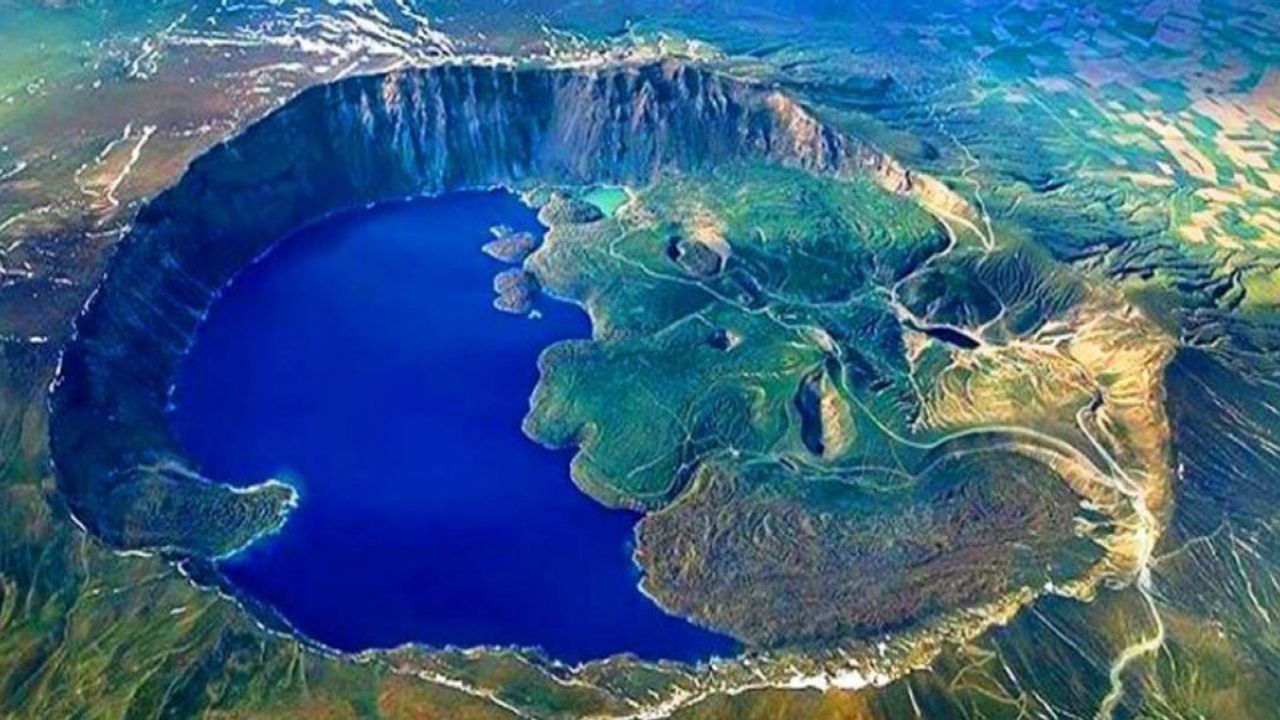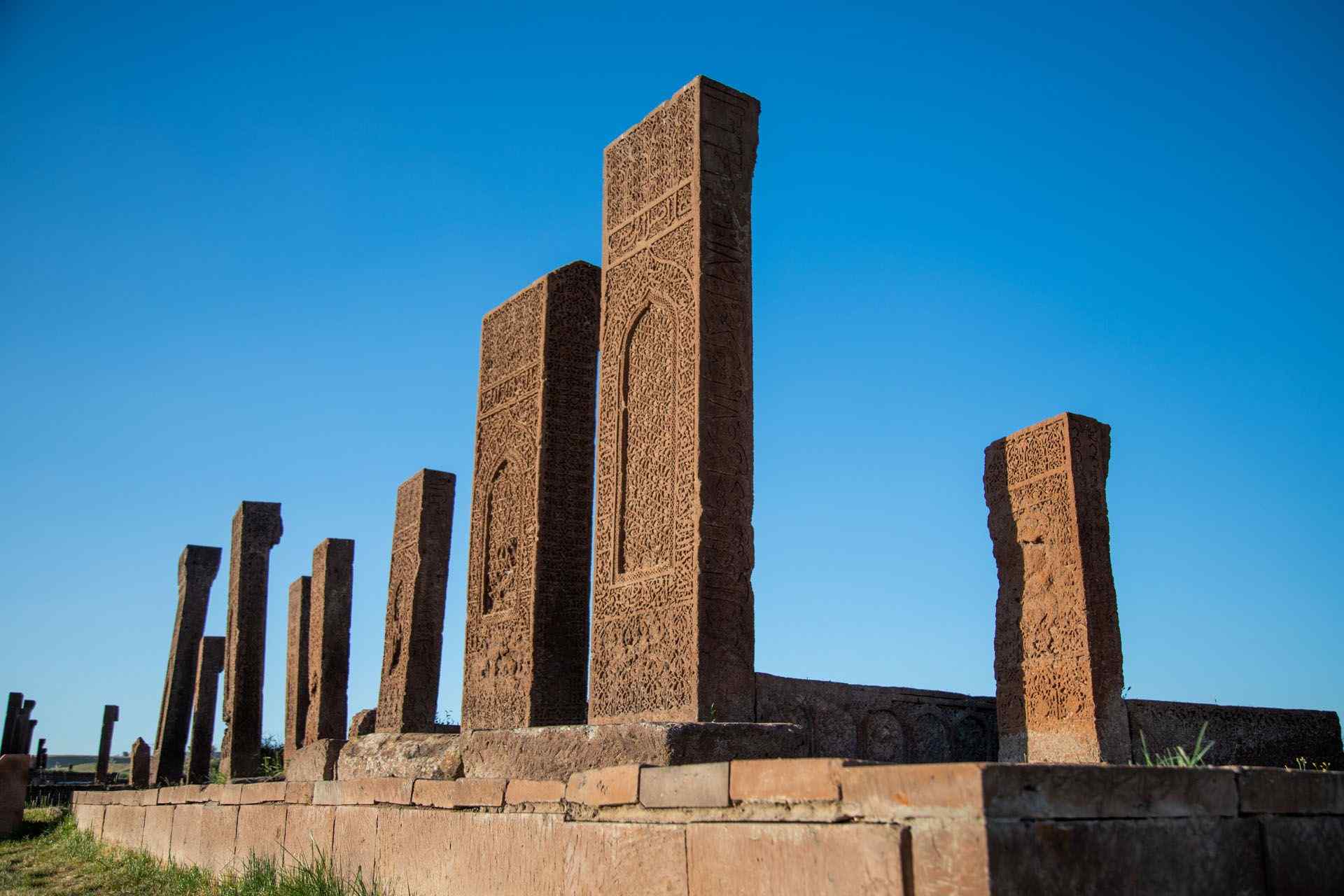 Turkey is one of the 2 volcanoes that have records of activity in historical times. There are short notes based on observations in Strabo's book about Mount Erciyes. For Nemrut; more extensive information is found in H.Abich's work and J.Frödin's article. The source of both researchers' information about this mountain is a work called Haissmavoruk written by an Armenian named Vardan in the XVth century. According to H. Abich's translation of the section on Nemrut in this work, ‘In 1441, a great event took place and the mountain Mahrut (Nemrut), located between Chat (Ahlat) and Bagesch (Bitlis), emitted sounds resembling thunder, and everyone was terrified and terrified, because the mountain was split as wide as a city, and a fire surrounded by a very dark smoke was seen to come out of the split, and a deadly foul smell made people sick. Under the influence of the terrific fire, the stones turned into embers and enormous volumes of rocks were thrown into the air with thunderous roars...‘’ The existence of this information has led the volcano of Nemrut to be considered among the active volcanoes of historical times. There can be no doubt that these descriptions explain a typical volcanic eruption; in fact, it cannot be claimed that Nemrut is completely extinct, because the presence of a hot lake in its caldera and the fact that hot gases are still coming out of the vicinity of this lake require the mountain to be considered as a volcano in a quiet period...
Turkey is one of the 2 volcanoes that have records of activity in historical times. There are short notes based on observations in Strabo's book about Mount Erciyes. For Nemrut; more extensive information is found in H.Abich's work and J.Frödin's article. The source of both researchers' information about this mountain is a work called Haissmavoruk written by an Armenian named Vardan in the XVth century. According to H. Abich's translation of the section on Nemrut in this work, ‘In 1441, a great event took place and the mountain Mahrut (Nemrut), located between Chat (Ahlat) and Bagesch (Bitlis), emitted sounds resembling thunder, and everyone was terrified and terrified, because the mountain was split as wide as a city, and a fire surrounded by a very dark smoke was seen to come out of the split, and a deadly foul smell made people sick. Under the influence of the terrific fire, the stones turned into embers and enormous volumes of rocks were thrown into the air with thunderous roars...‘’ The existence of this information has led the volcano of Nemrut to be considered among the active volcanoes of historical times. There can be no doubt that these descriptions explain a typical volcanic eruption; in fact, it cannot be claimed that Nemrut is completely extinct, because the presence of a hot lake in its caldera and the fact that hot gases are still coming out of the vicinity of this lake require the mountain to be considered as a volcano in a quiet period...
 Ahlat, which is the most important point of the entrance gate to Anatolia and the crossroads of the east-west synthesis, stands out with its geographical and historical features. In the XIIIth century, it became one of the 3 great centres of science, culture and art of the Islamic World with ‘Balkh (Afghanistan) and Bukhara (Uzbekistan)’ and increased its importance even more by taking the title of Kubbet-ül Islam.
Ahlat, whose history dates back to Neolithic Ages, remained under the rule of various states starting with the Hurris in 4000 BC and until the Ottomans. After 1071, when the gates of Anatolia were opened to the Turks, it became a base for the transition from east to west. Since the beginning of the XIIth century, it became the capital of a branch of the Seljuks called ‘Ahlatşahlar’.
Ahlat has been the centre of various civilisations in every period of history with its strategic importance and natural beauties. The city was pronounced as ‘Khlat’ during the Byzantine period, ‘Khelath’ during the Assyrian period, ‘Halat’ during the Arab period, and ‘Ahlat’ during the Iranian and Turkish periods.
In addition to the beauties of Ahlat, it is almost an open-air museum with its historical buildings such as many clusters, tombs, baths, baths, zawiyahs, clothworks, fountains, castles, cemeteries, mosques, civil residences, archaeological sites, aqueducts and caves. One of the most important of these historical buildings is the ‘Seljuk Square Cemetery Ruins’...
Ahlat, which is the most important point of the entrance gate to Anatolia and the crossroads of the east-west synthesis, stands out with its geographical and historical features. In the XIIIth century, it became one of the 3 great centres of science, culture and art of the Islamic World with ‘Balkh (Afghanistan) and Bukhara (Uzbekistan)’ and increased its importance even more by taking the title of Kubbet-ül Islam.
Ahlat, whose history dates back to Neolithic Ages, remained under the rule of various states starting with the Hurris in 4000 BC and until the Ottomans. After 1071, when the gates of Anatolia were opened to the Turks, it became a base for the transition from east to west. Since the beginning of the XIIth century, it became the capital of a branch of the Seljuks called ‘Ahlatşahlar’.
Ahlat has been the centre of various civilisations in every period of history with its strategic importance and natural beauties. The city was pronounced as ‘Khlat’ during the Byzantine period, ‘Khelath’ during the Assyrian period, ‘Halat’ during the Arab period, and ‘Ahlat’ during the Iranian and Turkish periods.
In addition to the beauties of Ahlat, it is almost an open-air museum with its historical buildings such as many clusters, tombs, baths, baths, zawiyahs, clothworks, fountains, castles, cemeteries, mosques, civil residences, archaeological sites, aqueducts and caves. One of the most important of these historical buildings is the ‘Seljuk Square Cemetery Ruins’...
 In the Adilcevaz article of the Turkish Encyclopaedia, the old name of the region is Arcige. In some documents belonging to the General Directorate of Foundations, the region is referred to as Zatu'l- Cevaz in Arabic, meaning the Valley of Walnuts.[3] Adilcevaz district was called Ardzgue by the Armenians living in the region.[4] There is a castle belonging to the Urartians in the north of the district, today known as Kef Castle.[5]
Adilcevaz's history is quite old. The history of the region dates back to the Chalcotic age. Assyrians dominated the region first. Later, Urartus settled in Lake Van and its surroundings. Persians (700 BC) and Macedonians (330 BC) dominated here. Arab raids reached here in 700 AD, and in the following years the region was the scene of constant wars between the Arabs and the Byzantines and changed hands from time to time between both communities. After the Battle of Malazgirt (1071), the Turks began to dominate the region. After Yavuz Sultan Selim's Battle of Chaldiran (1514), it joined the Ottoman lands. Although the Russian occupation during the First World War and the Armenians tried to dominate this region afterwards, the Turkish sovereignty in the region became clear with the Gyumri Treaty signed between the Government of the Grand National Assembly of Turkey and Armenia...
[Wikipedia]
In the Adilcevaz article of the Turkish Encyclopaedia, the old name of the region is Arcige. In some documents belonging to the General Directorate of Foundations, the region is referred to as Zatu'l- Cevaz in Arabic, meaning the Valley of Walnuts.[3] Adilcevaz district was called Ardzgue by the Armenians living in the region.[4] There is a castle belonging to the Urartians in the north of the district, today known as Kef Castle.[5]
Adilcevaz's history is quite old. The history of the region dates back to the Chalcotic age. Assyrians dominated the region first. Later, Urartus settled in Lake Van and its surroundings. Persians (700 BC) and Macedonians (330 BC) dominated here. Arab raids reached here in 700 AD, and in the following years the region was the scene of constant wars between the Arabs and the Byzantines and changed hands from time to time between both communities. After the Battle of Malazgirt (1071), the Turks began to dominate the region. After Yavuz Sultan Selim's Battle of Chaldiran (1514), it joined the Ottoman lands. Although the Russian occupation during the First World War and the Armenians tried to dominate this region afterwards, the Turkish sovereignty in the region became clear with the Gyumri Treaty signed between the Government of the Grand National Assembly of Turkey and Armenia...
[Wikipedia]